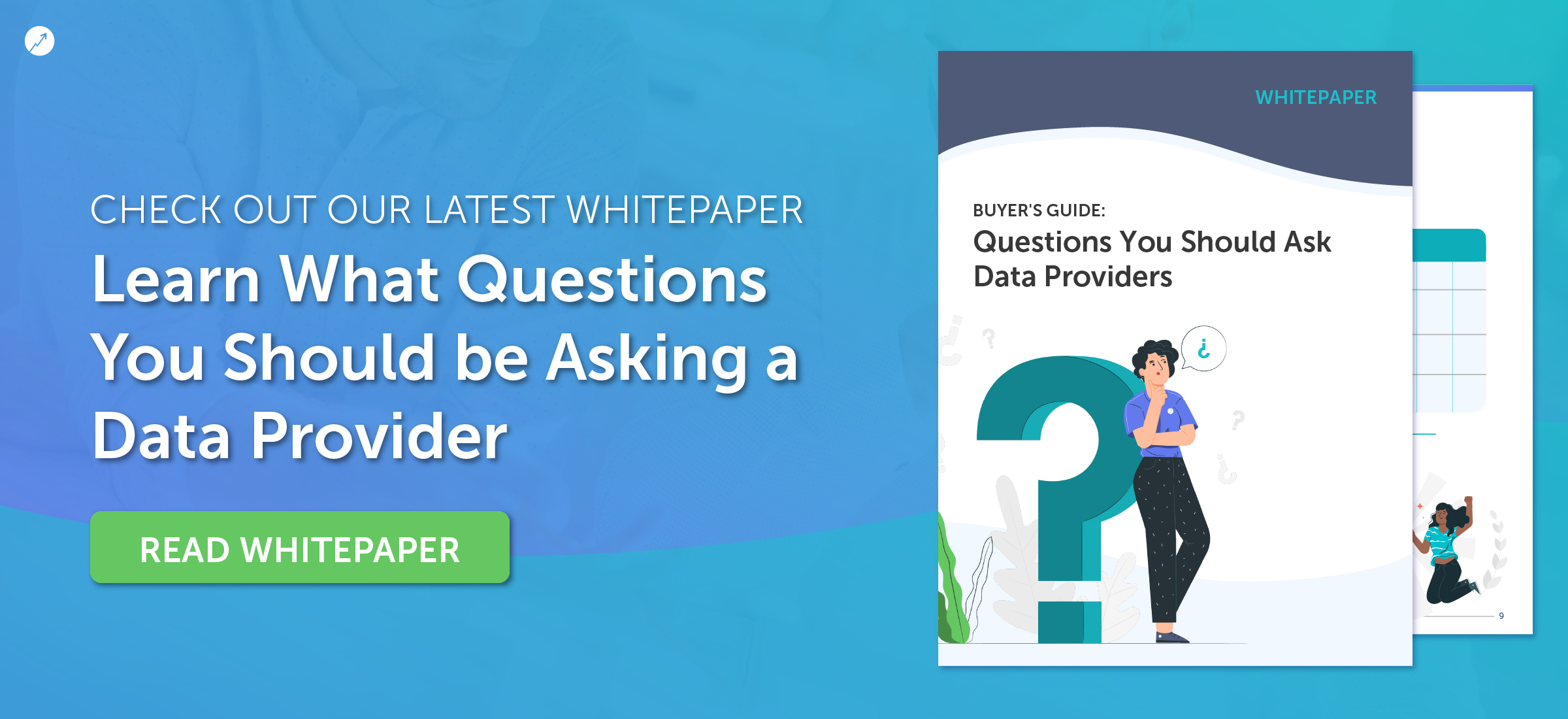Imagine you are the leader of a band performing in a rock concert. Would you play classical music in front of an audience who wants rock?
No, right?
Now back to reality – Mr.Smith is your potential customer and looking for a CRM. Will you try selling him an email marketing platform just because you think it might help him? If you are trying to sell the same thing to everyone then you are throwing spaghetti on the wall hoping a little might stick. The majority of your efforts will be wasted.
It’s all about knowing your audience as closely as possible. That’s where data comes in to help you with hitting right on the dartboard every time.
This article covers all that you need to know about B2B data. Whether you are just exploring B2B data or thinking about buying it, this article will help.
- What Type of Data is Right for Your Company?
- Firmographic Data
- Technographic Data
- Buyer Intent Data
- What is Data Enrichment, and Why is it Essential?
- Importance of Direct Dial in Your Data
- Data Quantity or Quality?
- Why Data Accuracy is Crucial
- Difference Between Machine-verified and Human-Verified Data
- How to Find The Best B2B Data Partner for Your Business
What Type of Data is Right for Your Company?
A solid B2B communication database is at the heart of any efficient marketing and sales plan. It doesn’t matter whether you have a small or big organization. It’s crucial to have the correct knowledge of your prospects and leads.
The more you understand your future clients, the more effectively you can sell to them, design goods and services that meet their demands, get strategic insight, proactively spot patterns in buying intent and behavior, and increase your chances of success.
Choosing the appropriate B2B data will have a direct impact on the efficacy of your marketing and sales approach. The B2B data categories listed below must be included in your database to guarantee a more concentrated approach in your marketing efforts as well as a tailored sales message to your prospects and leads.
Firmographic Data: Firmographic data contains important company details that help you categorize accounts (companies) suitable for you.
Contact Data: These are the key items– think of the contact details as the enabler or the real information that helps you contact the people behind the accounts on the list.
Technographic Data: Technographic data contains technologies that are used by the target accounts/companies.
Intent Data: Intent data analyzes the buying intent of the people in your target accounts.
The above mentioned are the must-have data sets to boost the sales process and close more B2B sales. You can dive deeper into each data set and its significance. Given that, you also need to make sure that the data you use is accurate and up-to-date.
Firmographic Data
A planned sales speech is likely to cause the prospect on the other end of the telephone to hang up on you mid-sentence in today’s hyper-competitive market climate. When it comes to dealing with poorly targeted sales efforts, company data is the way to go.
Identifying the correct prospects is one of the most difficult aspects of B2B sales. Businesses spend a lot of money to fill their sales funnel, but many of the leads are unqualified. Even if they are qualified, the efficacy of your outreach will suffer if you are unable to appropriately segment your targets. Segmenting your audience makes it far easier to develop relevant content that converts prospects into leads and leads into customers. “If you target everyone, you will target no one,” as the old marketing adage goes.
Firmographic information includes both company-wide and detailed user-level data. B2B segmentation with firmographics allows you to construct a picture of who your clients are so that you can target specific markets with relevant content.
Here’s an article that explains all you need to know about firmographic data and how you can use it for focused targeting.
Technographic Data
Technology is a catalyst for businesses to achieve revenue growth. As an acknowledgment of this data-driven phenomenon, technographics seek to partition technology into numerous factors at a granular level.
After Demographics, Firmographics, and Psychographics, Technographics is the next step in market research development. In the same way that demographics influence people’s actions, technographics influence the technologies that your prospects employ. With technographic data, you may acquire an in-depth understanding of a company’s technology stack and its possible plans to purchase technical solutions in the future.
If you don’t understand the function of technographic data in prospecting, a data source offering it as a value-add may not excite you. With the rising use of technology, technographic data has the potential to become an important prospecting tool.
Learn more about technographic data and how it can help you drive more sales.
Intent Data
A great grasp of customer needs backed up by data intelligence will not only provide you a competitive advantage but will also assist you in building a strong and consistent funnel for the sales team. However, only a few marketers and sales professionals understand how to use data wisely to genuinely benefit. Intent Data is one of the most significant pieces of data for driving sales and marketing insights.
Buyer Intent Data data helps you to identify prospects actively engaged in a buying decision based on the type of content they are consuming.

Once you’ve connected the dots between what your B2B consumers require and their buying signals, you can start distributing particular content that will assist them to reach their objectives while also creating an opportunity for you.
Intent Data might seem complex to understand and use. That’s why we have a detailed article on Intent Data that explains the concept in the simplest way and how to get the data.
What is Data Enrichment, and Why is It Essential?
To derive valid insights from company data, and ultimately improve sales, marketers and sales reps must be confident about their data’s accuracy and completeness.
Here’s an example:
Suppose Mr.Smith (your lead) has downloaded a case study from your website. You have tagged him as a TOFU (Top of Funnel) lead and started nurturing him through the funnel. You don’t have complete data on his organization as you kept the form limited to name and email address.
Now, you have all the necessary data to contact the lead. You nurtured the lead, did all the right things, but then you discovered he is not a sales-qualified lead. His company is too small to use your product. The reason behind ‘closed lost’ is incomplete data. And this is where enriching your CRM data becomes crucial.
Data enrichment is the method of integrating raw data from your internal resources with data from other internal or external data sets.

Data enrichment is a valuable commodity since it transforms raw data into useful and insightful details for any organization. The majority of brands enrich their raw data so that it may be used for informed decision-making.
Read the complete data enrichment guide for understanding the purpose and process of data enrichment
Importance of Direct Dials in Your Data
More than ever, sales efficiency is critical. Accurate direct dials save your sales reps time dialing to make relationships. They also aid in the expansion of your sales funnel and, as a result, your earnings. As a result, figuring out how to avoid calling switchboards and gatekeepers should be a top focus for any outbound team. Finding direct work mobile numbers is one of the best and simplest methods.

If you call a company’s switchboard and ask for a decision-maker from higher management, the gatekeeper is likely to refuse you access. It takes 22 minutes on average to connect using switchboard numbers, but just five minutes to connect using direct dial numbers.
Work Mobile Numbers directly impact the amount of time it takes to identify and reach decision-makers. Sales reps end up using fewer resources in terms of calling time as well as managing numerous channels to pursue and convert decision-makers. Learn more about how direct work mobile dials can help you resolve the challenges throughout the sales process.
Data Quantity or Quality?
The traditional sales or marketing approach holds that the greater your reach, the more chances you may generate. With this approach, data volume takes the lead, while quality takes a back seat. However, we must reconsider and see that the consistency of our data is now the most important factor.
When it comes to numbers, quantity does not always equal profit. Obtaining a large database is insufficient. It has the potential to muddy the waters and make decision-making more complicated, leading to increased expenses and reduced production.
Suppose you receive 50 human-verified connections who are certain to buy anything from you this year. On the other hand, you are given 20,000 entirely random contacts who may or may not become your clients. So, would you rather have 50 ready-to-buy verified contacts than 20,000 contacts into which you have no visibility?
While this is just one example of comparison, here’s a complete article that will give you a clear choice when choosing between the two.
Why Data Accuracy is Crucial
The success of your marketing efforts depends on three major factors: content, audience, and data health. Data health is the quality of the database used in your email campaigns. Maintaining data hygiene is a must when it comes to getting your emails delivered to your subscribers’ inboxes.
Top Reasons for Maintaining Data Hygiene:
- Inaccurate data wastes 27.3% of sales reps’ time. That’s 546 hours a year.
- 88% of companies believe data hygiene has a direct impact on ABM success
- The average company is losing 12% of its revenue.
- 21% of brands experienced reputational damage.
Poor data hygiene can have a huge impact on your email campaigns. For instance, poor data hygiene will reduce email delivery rates and have a negative influence on open, response, and click-through rates, resulting in a decrease in the amount of ROI you will generate from email marketing.
So, maintaining data accuracy should be your first priority before using it for your marketing and sales campaigns.
Difference Between Machine-verified and Human-Verified Data
Having an accurate list of data is a major challenge because numerous issues can be linked with B2B data, such as data completeness, dependability, consistency, timeliness, relevancy, redundancy, and so on. If your sales agents use data that has not been subjected to a rigorous verification process, they are potentially squandering 27.3 % of their time.
There are two major data verification processes of data collection – machine processed and human-verified.
Machine Processed Data: A machine learning algorithm is used to collect (and verify) machine-processed data. The data is collected in bulk.
Human-Verified: Human-verified, as the name suggests, is data verified by humans. The volume of human-verified data is frequently less than that of machine-processed data.
Learn more details about the data battle between machine-processed and human-verified data.
How to Find The Best B2B Data Partner for Your Business
Preparing your database might take a significant amount of time and effort. The simplest method to accomplish this is to use a sales intelligence platform.
Many B2B organizations rely on a data partner to help them reach decision-makers to save time on database preparation and spend more time on execution.
However, with so many B2B data partners and sales intelligence systems to select from, it can be tough to choose one that meets your needs while also providing accurate data within your budget. Although deciding who to work with can be difficult, you can specify a few parameters when considering data partners.
Here’s a six-step process to choose the right B2B data partner for your business.






